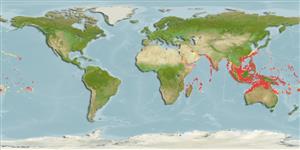>
Carangaria/misc (Various families in series Carangaria) >
Sphyraenidae (Barracudas)
Etymology: Sphyraena: Greek, sphyraina, -es = the name of a fish (Ref. 45335).
Eponymy: Johann Reinhold Forster (1729–1798) was a German clergyman in Danzig (now Gdansk, Poland). [...] (Ref. 128868), visit book page.
More on author: Cuvier.
Environment: milieu / climate zone / depth range / distribution range
Ecologia
marinhas associadas(os) a recifes; intervalo de profundidade 6 - 300 m (Ref. 1602). Tropical; 30°N - 23°S, 36°E - 140°W
Indo-Pacific: East Africa to Southeast Asia and the Marquesan and Society islands, north to southern Japan, south to New Caledonia.
Tamanho / Peso / Idade
Maturity: Lm ? range ? - ? cm
Max length : 92.3 cm FL macho/indeterminado; (Ref. 125599); common length : 50.0 cm TL macho/indeterminado; (Ref. 9768); peso máx. publicado: 4.1 kg (Ref. 125599)
Espinhos dorsais (total) : 6; Raios dorsais (total) : 9; Espinhos anais: 2; Raios anais : 9. Body elongate and sub cylindrical with small cycloid scales; head long and pointed. Mouth large and horizontal, the tip of the lower jaw protruding; intermaxilla non-protractile. Preoperculum broadly rounded. Lower limb of the first fill arch with spiny tubercles. First dorsal fin origin opposite or before the pectoral tip, the first spine shorter than the second. Color is generally blackish above and silvery below.
Nocturnally active, but occurring in large schools above lagoon patch reefs and along outer reef slopes during the day (Ref. 9768, 48637). Feeds mainly on fishes, but also on penaeid shrimps and squids. Sold fresh, frozen or dried salted. Reports of ciguatera poisoning need confirmation.
Ciclo de vida ou comportamento de acasalamento
Maturidade | Reprodução | Desova | Ovos | Fecundidade | Larvas
Rose, J.H., 1984. Sphyraenidae. In W. Fischer and G. Bianchi (eds.) FAO species identification sheets for fishery purposes. Western Indian Ocean (Fishing Area 51). Vol. 4. FAO, Rome. pag. var. (Ref. 4752)
Status na Lista Vermelha da UICN (Ref. 130435: Version 2024-2)
Ameaça para os humanos
Reports of ciguatera poisoning (Ref. 30298)
Uso pelos humanos
Pescarias: espécies comerciais
Ferramentas
Relatórios especiais
Baixar XML
Fontes da internet
Estimates based on models
Preferred temperature (Ref.
123201): 19.4 - 28.2, mean 26.2 °C (based on 976 cells).
Índice de diversidade filogenética (Ref.
82804): PD
50 = 0.5000 [Uniqueness, from 0.5 = low to 2.0 = high].
Bayesian length-weight: a=0.00724 (0.00481 - 0.01092), b=2.92 (2.80 - 3.04), in cm total length, based on LWR estimates for this species & Genus-body shape (Ref.
93245).
Nível Trófico (Ref.
69278): 4.4 ±0.0 se; based on diet studies.
Resiliência (Ref.
120179): Baixo, tempo mínimo de duplicação da população 4,5 - 14 anos (Preliminary K or Fecundity.).
Fishing Vulnerability (Ref.
59153): High vulnerability (61 of 100).
Nutrients (Ref.
124155): Calcium = 16 [7, 42] mg/100g; Iron = 0.289 [0.130, 0.614] mg/100g; Protein = 20.1 [18.1, 21.7] %; Omega3 = 0.103 [0.048, 0.214] g/100g; Selenium = 46.3 [20.1, 115.3] μg/100g; VitaminA = 46.7 [10.3, 220.9] μg/100g; Zinc = 0.448 [0.286, 0.779] mg/100g (wet weight);
